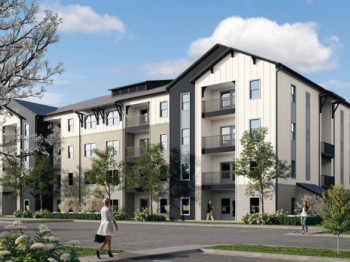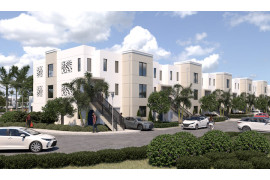Trending Multifamily News
Market conditions for the apartment industry remained soft in the National Multifamily Housing Council’s (NMHC) October Quarterly Survey of Apartment Market Conditions. While the Market Tightness (37), Sales Volume (45) and Equity Finance (46) Indexes remained below the breakeven level of 50 – with the Debt Financing Index (51) edging just above 50 – there was little change compared with three months earlier.
“The apartment market is headed into a seasonally slow leasing period with new deliveries easing upward pressure on rents and occupancy rates in many markets around the country,” said NMHC Chief Economist Mark Obrinsky. “The big increase in multifamily starts in 2015 and 2016 is finally filtering through to the marketplace on a broad basis.”
“Leasing activity appears to have picked up in Texas and Florida in the aftermath of Hurricanes Harvey and Irma. Some respondents also noted that fires on the West Coast may be pushing occupancy rates up,” said Obrinsky. “Elsewhere, new deliveries are leading to concessions becoming more commonplace.”
The Market Tightness Index decreased from 42 to 37, marking the eighth consecutive quarter of overall declining conditions. Forty percent of respondents reported looser conditions than three months prior, compared to just 14 percent who reported tighter conditions.
The Sales Volume Index declined two points to 45. Over a quarter (28 percent) of respondents indicated lower sales volume compared to the previous three months, compared to 19 percent who reported higher volume over the past quarter.
The Equity Financing Index remained unchanged at 46, with almost two-thirds (62 percent) reporting unchanged conditions. This marks the eighth consecutive quarter of declining conditions.
The Debt Financing Index increased from 47 to 51, crossing the breakeven level of 50 for the first time since July 2016, indicating improving overall conditions. While most respondents (62 percent) reported unchanged conditions, 14 percent believed that conditions for debt financing had become more favorable. Conversely, 12 percent of respondents reported worse conditions for debt financing compared to three months prior.
About the Survey:
The October 2017 Quarterly Survey of Apartment Market Conditions was conducted October 10-October 17, 2017; 139 CEOs and other senior executives of apartment-related firms nationwide responded.
View the full data online at nmhc.org/QS-October-2017
All four indexes of the National Multifamily Housing Council’s (NMHC) July Quarterly Survey of Apartment Market Conditions remained slightly below the breakeven level of 50, the fourth consecutive quarter indicating softening conditions. The Market Tightness (43), Sales Volume (47), Equity Financing (46), and Debt Financing (47) Indexes all improved from April, but still hovered just below 50.
“All four indexes are below 50 but rising, suggesting that the softening is less wide-spread than in previous quarters,” said Mark Obrinsky, NMHC’s SVP of Research and Chief Economist. “Despite some softness at the high end of the apartment market—due to construction having finally ramped up to the level needed—demand for apartments will continue to be substantial for years to come.”
The Market Tightness Index edged up from 41 to 43, as almost half of respondents (48 percent) reported unchanged conditions. One-third (33 percent) of respondents saw conditions as looser than three months ago, while the remaining 19 percent reported tighter conditions. This marks the seventh consecutive quarter of overall declining conditions.
The Sales Volume Index increased from 30 to 47, just shy of the breakeven level of 50. Twenty-seven percent of respondents reported higher sales volume than three months prior, compared to 33 percent that reported lower volume.
The Equity Financing Index increased four points to 46, with almost a quarter (24 percent) of respondents believing that equity financing was less available than three months prior. Sixteen percent thought that equity financing was more available compared to three months ago.
The Debt Financing Index increased from 41 to 47, showing a similar trend to the equity market. While a quarter of respondents (25 percent) reported worse conditions for debt financing compared to three months prior, another 19 percent disagreed, believing conditions had become more favorable.
About the Survey:
The July 2017 Quarterly Survey of Apartment Market Conditions was conducted July 10-July 17, 2017; 123 CEOs and other senior executives of apartment-related firms nationwide responded.
A report by Hoyt Advisory Services, Dinn Focused Marketing, Inc. and Whitegate Real Estate Advisors, LLC prepared for the National Multifamily Housing Council and the National Apartment Association was released. You can download the entire report here. Below is the executive summary:
The housing bubble fallout of 2007-2010 resulted in a paradigm shift in the U.S. among many households. Disillusioned by the bursting of the house price bubble that destroyed equity, many former home owners continue to rent today. Younger households, seeking more mobility and often saddled with student loans, postpone home ownership or choose to have the flexibility of renting. Demographic shifts also affect home ownership and the result has been a declining home ownership rate and corresponding increase in the percentage of households that rent. Some of this shift came about in the same housing units, as owned units became part of the rental inventory and today some one-third of all rental units are single-family units.
Tighter underwriting standards by lenders have resulted in a tighter supply of both multifamily and single-family housing with prices and rents exceeding the growth in income for the past decade. Housing affordability, especially on coastal markets, remains low.
Housing supply is adequate in most markets but there are many exceptions especially along the Northeast and Western U.S. coasts at certain price segments. Affordable market-based housing is only achievable with greater density and smaller sized units, yet land-use policies and political approval processes have moved in the opposite direction adding greater regulation and restrictions. The internet and social media have facilitated quick mobilization for groups that feel threatened by new housing developments that will add traffic and parking congestion in their neighborhood.
Demographic shifts, student debts and tighter underwriting continue to suggest substantial rental demand in the future. Among the major drivers of metro and state level household growth are in-migration policies and trends. As a whole, the U.S. depends on immigration to fuel the labor market. Any declines in immigration rates will severely curtail both the growth of the U.S. economy and future housing demand. In recent years, several metropolitan areas would have had zero or negative population growth were it not for international in-migration. Their natural population increases have been more than offset by domestic out migration and yet international migration has significantly supplemented the population. These metros include1 Chicago, Detroit, Milwaukee, Philadelphia, St. Louis and New York.
Among the metro markets studied, migration rates are a key telltale sign of the local economy’s direction. Those metros with strong economies also have significant population growth rates often derived from in-migration from both domestic and international sources. Examples include Houston, Charlotte, Austin and Tampa-St. Petersburg. Markets such as Washington D.C. and San Diego have strong international in-migration but experience domestic out-migration.
Uncertain in our housing outlook is the longevity of the current rental stock. This study assumes a base rate of economic obsolescence of 0.5% or 720,000 units per year on average through 2030. If the economic life of a housing unit is reduced to 100 years (1.0% per year), on average, then we need 1.4 million housing units per year just to replace the lost housing units. The type of housing needed in the future is also shifting towards units that accommodate older households.
Given the maturity of the current economic cycle, the forecast assumes that the U.S. economy could go through two recessions by the end of the forecast period in 2030. Even under this scenario, all 50 states and the 50 metropolitan markets in this study will need new multifamily housing going forward to meet a growing population base. The Southern states driven by economic growth, low costs and diversified demographic growth continue to lead demand forecasts with metropolitan markets in Texas and Florida ranked in 5 of the top 6 places. Phoenix, Atlanta, Raleigh and Las Vegas also rank in the top 10. Slower growth markets are more likely to experience new demand growth in specific neighborhoods. Developers and investors should evaluate these markets carefully for new growth as well as revitalization of existing neighborhoods. These markets are frequently located in the Midwest and Old South and include markets such as Cleveland, Milwaukee, Birmingham, Pittsburgh and New Orleans.
Growth drivers also vary greatly by metro market and will shape the format of new construction going forward. A few markets will continue to attract new renters of all ages, while many will experience an increasing proportion of demand from 35+ aged cohorts. The 65+ aged cohort will account for a large part of demand in some low growth markets, particularly those experiencing net out-migration trends. Income and ethnicity trends also vary significantly by market.
While some markets embrace growth, others are restricted either geographically and / or by policy. Supply-restricted markets tend to have higher rental costs and lower affordability. Markets with both high rental and high for-sale housing costs risk losing population bases to lower cost areas. The middle class, including necessary professions for a healthy economy such as teachers, police and fire-fighters, cannot afford average rents in these markets. States with healthy balance sheets and educated workforces continue to be primed to attract individuals and firms from these markets.
Several ‘known unkowns’ could occur going forward that would significantly change the forecast. At the national level, 75% of the variance in the U.S. home ownership rate since 1971 can be explained by policy changes such as those that impact capital and banking markets. It is unknown whether policy changes will be put into effect which could impact the applicability of the mortgage tax deductions, particularly for middle income families. Changes in these policies can affect the ‘own vs. rent’ decision and thus the amount of demand for multifamily properties going forward2 .
The second large ‘known unkown’ at the national level at the time of writing this report is the impact of policy changes on immigration rates. As the U.S. population ages, growth is slowing and becoming increasingly dependent on immigrants who have a higher tendency to rent. As a base case, population growth is expected to slow from 0.9% per year on average from 2000 to 2010 to 0.7% on average from 2016 through 2030. Under this scenario, immigration begins to outpace natural growth (births minus deaths) by 2023. Without immigration, population growth is expected to slow to 0.4% per year through 2030, less than half the pace of the past decade.
At the local level, some markets could surprise on the upside. For example, large tech campuses continue to expand in Seattle. A growing hub of large tech firms could attract more than expected small tech firms as well as individuals looking to escape the high costs of Silicon Valley. Detroit is at the other end of the growth spectrum but has been increasingly attracting a few investors who are aggregating large tracts of land.
Atlanta-based multi-family owner and management firm, JMG Realty Inc., announced today that the firm has been ranked one of the 50 largest multi-family managers in the country by the National Multifamily Housing Council when it released its annual list of Top 50 Managers, as reported by Multifamily Executive Magazine. Since 1990, the NMHC has released their much-anticipated results each year for the Top 50 Managers and serves as the authoritative rankings of the nation's leading apartment firms.
In 2016, JMG experienced strong portfolio growth to move them into this year's rankings. To continue the growth of their management footprint, JMG opened a new regional office earlier in 2016 which oversees the Mid-Atlantic and Northeast portfolio's where they continue to see opportunities.
Tim Brock, President of JMG Realty, noted that the firm's involvement in several new joint ventures with development partners in Florida, and solid organic growth in third-party management assignments for stabilized assets and new construction lease-ups, has served as a strong catalyst for our growth over the past year.
JMG looks forward to continued growth in their ownership and management footprint across the country throughout 2017.
Industry leaders Ken Bacon (RailFeild Realty Partners), Laurie Baker (Camden Property Trust), William J. Ferguson (Ferguson Partners Ltd. and FPL Advisory Group), Mitch Harrison (First Communities), and Julie Smith (The Bozzuto Group) make the business case for diversity and inclusion during the 2017 NMHC Annual Meeting general session.
The National Multifamily Housing Council (NMHC) has been named a 2017 ENERGY STAR Partner of the Year – Energy Efficiency Program Delivery Award for sponsoring programs to improve the energy efficiency of the nation’s 20 million apartment homes.
“With one in seven households living in an apartment, multifamily buildings represent a tremendous opportunity to increase the nation’s energy efficiency,” said NMHC President and CEO, Doug Bibby. “We are extremely honored by this award from the U.S. Environmental Protection Agency and look forward to continue building on this important work.”
NMHC earned the recognition for its multi-pronged campaign to engage the industry to increase energy efficiency. Elements included:
- CEO-level effort aimed at facilitating access to accurate, aggregated whole building utility consumption data to drive investment in properties.
- Regular communications including meeting presentations to the industry on energy efficiency strategies.
- A portal to highlight ENERGY STAR tools, including Portfolio Manager for the industry.
- A national survey of apartment residents to understand renter preferences of green/energy efficient apartment features to help inform future ENERGY STAR branding and outreach to the sector.
For a complete list of 2017 winners and more information about ENERGY STAR’s awards program, visit www.energystar.gov/awardwinners.
Download a high resolution photo here.














